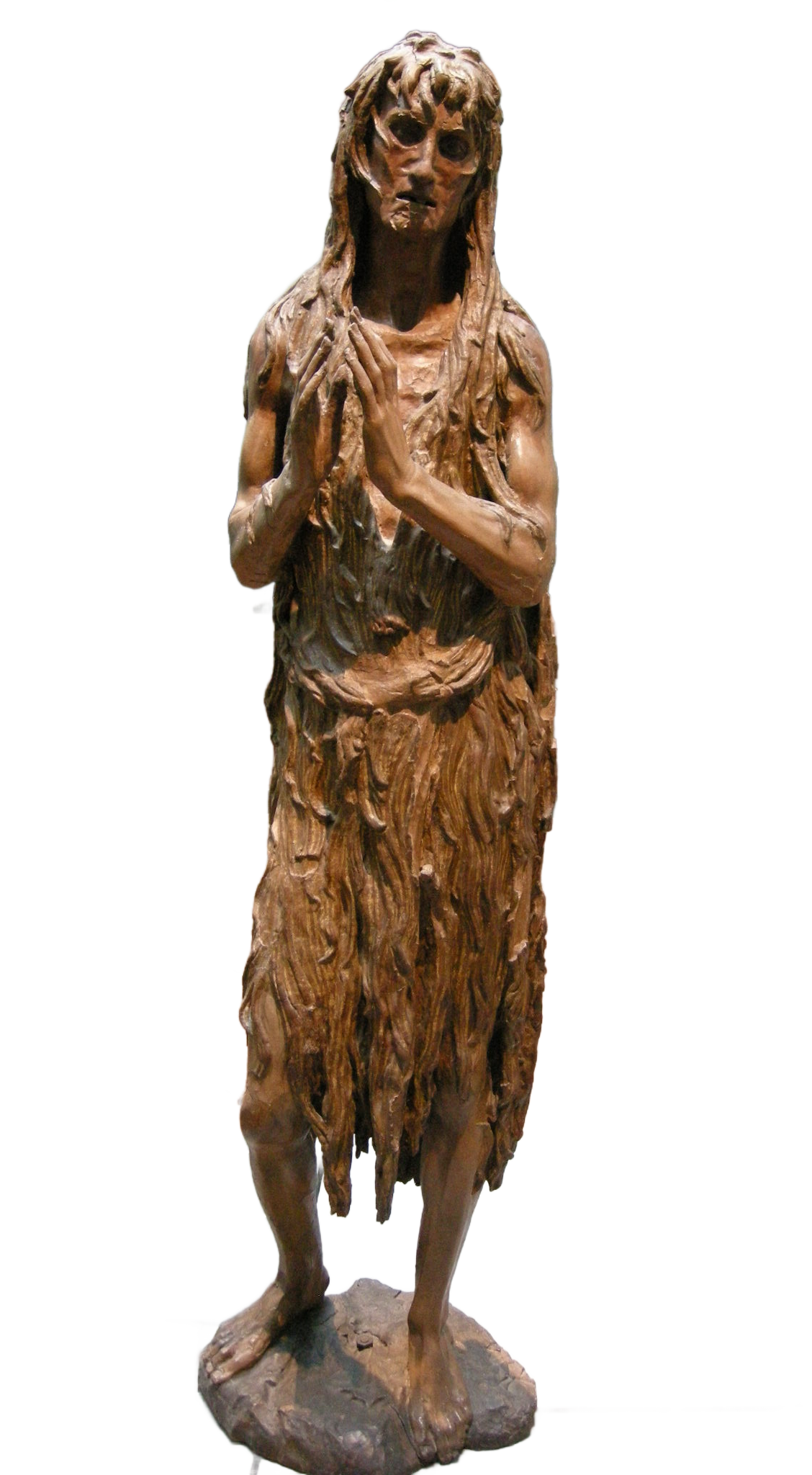Mary Magdalene, Crone
In 1440, or thereabouts, the sculptor Donatello carved a rather extraordinary figure of Mary Magdalene. While the hands and feet show a careful attention to realism, the Magdelene’s face is rough-hewn, standing out against the dark hollow formed by the ragged veil of the hair that covers her whole body. Her haunted eyes are sunk deep in her skull. This is Mary Magdalene as an old woman.

This sculpture would have been brightly painted when it was new—see its companion for comparison—but there is something perfect about the dark, unadorned wood. I see, I think, what Linda Pastan was seeing when she wrote this poem:
Old woman,
enrobed in nothing
but faith
and strands of chiseled hair,
the living tree once hid
those gnarled limbs, that face
worn to its perfect bones
which has seen everything.
Hag of articulate wood,
before Donatello found you
how many leaves did you watch
detach themselves
from your twigged fingers,
how many branches stripped
and nailed
to make each crucifix?
The iconography we see here is complicated by the fact that by the medieval period, Mary Magdalene—one of Jesus’s followers, mentioned by name in every canonical gospel—had become conflated with Mary of Egypt, a Christian convert supposedly born sometime in the 4th century—although the earliest reference we have to her is from the 7th century. According to her vita, Mary of Egypt was a sex worker, but she was so insatiable that she sometimes refused to take money for her services. When she went to Jerusalem for the Exaltation of the Holy Cross, she wasn’t looking for salvation. She was hoping to find a lot of clients while the city was filled with pilgrims. It was only when a mysterious force prevented her from entering the Church of the Holy Sepulchre that she felt remorse for the lifestyle she had chosen. After that, she left the world behind for a life of penitence and ascetism in the desert.
While a life of sexual depravity was always at the center of Mary of Egypt’s story, Mary Magdalene didn’t become a prostitute until Pope Gregory I made her one in 591. In his Easter homily that year, he edited a bunch of New Testament Marys together and called this textual chimera “Mary Magdalene.” In Gregory’s sermon, Mary Magdalene becomes the woman who anoints Jesus’s head in Mark and Matthew; the “sinful woman” who washes Jesus’s feet with her tears before anointing them with oil in Luke; and Mary, the sister of Martha and Lazarus, who pours precious nard over Jesus’s feet and wipes them with her hair. (This is, by the way, is why an alabaster jar is also one of the iconographic motifs associated with the saint.)
If you haven’t already, this might be the point at which you’re thinking, “But what’s up with all the hair?”
I had to resist the urge to go on an exhaustive research field trip in trying to answer this question. My new benchmark is, if I’m downloading unpublished dissertations, I’ve gone too far and need to turn back immediately. So, I’m going to go with what I know right now, and knowing what I know right now, and I think working backwards makes the most sense.
By the time Donatello was turning a white poplar into Mary Magdalene, there was already a tradition in European folklore and visual arts of describing and depicting wild women as covered in hair, whether that means with thick hair falling from their head to their feet or an actual pelt growing all over their bodies. Mary Magdalene and Mary of Egypt are portrayed in both ways and, in both ways, hair is a polyvalent symbol.
On a wild woman—a woman who lives in the forest, an uncivilized woman—being covered with fur is a sign of her ambivalent status. Is she human, or is she an animal? But there are stories in which Mary Magdalene’s body hair is a miracle. It grows to cover her nakedness after her clothes disintegrated. As for long hair that is unbound, it can signify maidenhood or licentiousness and, in the case of Mary Magdalene and Mary of Egypt, it suggests a third category: that of repentant whore. I think that both Marys trouble the binaries associated with long, loose hair. Mary of Egypt was civilized to the extent that she was very much a part of the cosmopolitan culture of her day. It was only when she left the city for the desert, though, that she regained her full humanity in the eyes of the early Church.
The unbound hair we see in the gospels has context-dependent meaning, but if we’re trying to work with Pope Gregory’s pastiche version of Mary Magdalene, unbound hair means all of the above. The woman who anoints Jesus’s head with oil in Mark is taking on the role of a Temple priest. The “sinful woman” who wets Jesus’s feet with her tears and wipes them dry with her hair before anointing them is performing a particularly poignant version of a hospitality ritual, perhaps signifying her willingness to rejoin her community through renunciation of her old life and repentance—or, maybe, her desire to be a part of a new kind of community in which her “sins” do not exclude her.

